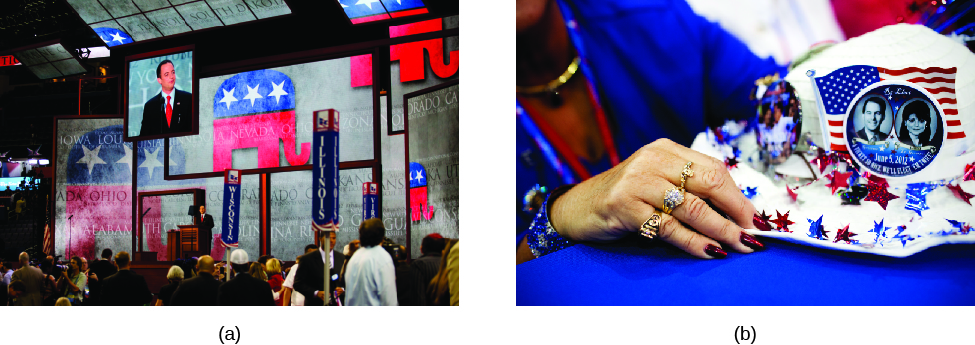CONVENTION SEASON
Once it is clear who the parties’ nominees will be, presidential and gubernatorial campaigns enter a quiet period. Candidates run fewer ads and concentrate on raising funds for the fall. This is a crucial time because lack of money can harm their chances. The media spends much of the summer keeping track of the fundraising totals while the political parties plan their conventions. State parties host state-level conventions during gubernatorial elections, while national parties host national conventions during presidential election years.
Party conventions are typically held between June and September, with state-level conventions earlier in the summer and national conventions later. Conventions normally last four to five days, with days devoted to platform discussion and planning and nights reserved for speeches (Figure). Local media covers the speeches given at state-level conventions, showing speeches given by the party nominees for governor and lieutenant governor, and perhaps important guests or the state’s U.S. senators. The national media covers the Democratic and Republican conventions during presidential election years, mainly showing the speeches. Some cable networks broadcast delegate voting and voting on party platforms. Members of the candidate’s family and important party members generally speak during the first few days of a national convention, with the vice presidential nominee speaking on the next-to-last night and the presidential candidate on the final night. The two chosen candidates then hit the campaign trail for the general election. The party with the incumbent president holds the later convention, so in 2016, the Democrats held their convention after the Republicans.

There are rarely surprises at the modern convention. Thanks to party rules, the nominee for each party is generally already clear. In 2008, John McCain had locked up the Republican nomination in March by having enough delegates, while in 2012, President Obama was an unchallenged incumbent and hence people knew he would be the nominee. In 2016, both apparent nominees (Democrat Hillary Clinton and Republican Donald Trump) faced primary opponents who stayed in the race even when the nominations were effectively sewn up—Democrat Bernie Sanders and Republican Ted Cruz—though no “convention surprise” took place. The naming of the vice president is generally not a surprise either. Even if a presidential nominee tries to keep it a secret, the news often leaks out before the party convention or official announcement. In 2004, the media announced John Edwards was John Kerry’s running mate. The Kerry campaign had not made a formal announcement, but an amateur photographer had taken a picture of Edwards’ name being added to the candidate’s plane and posted it to an aviation message board.
Despite the lack of surprises, there are several reasons to host traditional conventions. First, the parties require that the delegates officially cast their ballots. Delegates from each state come to the national party convention to publicly state who their state’s voters selected as the nominee.
Second, delegates will bring state-level concerns and issues to the national convention for discussion, while local-level delegates bring concerns and issues to state-level conventions. This list of issues that concern local party members, like limiting abortions in a state or removing restrictions on gun ownership, are called planks, and they will be discussed and voted upon by the delegates and party leadership at the convention. Just as wood planks make a platform, issues important to the party and party delegates make up the party platform. The parties take the cohesive list of issues and concerns and frame the election around the platform. Candidates will try to keep to the platform when campaigning, and outside groups that support them, such as super PACs, may also try to keep to these issues.
Third, conventions are covered by most news networks and cable programs. This helps the party nominee get positive attention while surrounded by loyal delegates, family members, friends, and colleagues. For presidential candidates, this positivity often leads to a bump in popularity, so the candidate gets a small increase in favorability. If a candidate does not get the bump, however, the campaign manager has to evaluate whether the candidate is connecting well with the voters or is out of step with the party faithful. In 2004, John Kerry spent the Democratic convention talking about getting U.S. troops out of the war in Iraq and increasing spending at home. Yet after his patriotic and positive convention, Gallup recorded no convention bump and the voters did not appear more likely to vote for him.